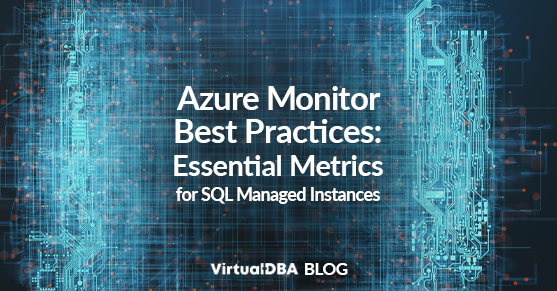Ensuring the performance and availability of your Azure Managed SQL databases is crucial for maintaining a smooth user experience and maximizing business productivity. Azure Monitor offers a robust suite of monitoring tools, but navigating the vast array of metrics can be overwhelming. This blog post delves into the best practice metrics you should configure in Azure Monitor to effectively monitor your SQL Managed Instances for optimal performance and reliability.
SQL Managed Instances Performance Metrics
- CPU Utilization: This metric indicates how busy the database CPU is. High utilization (consistently exceeding 90%) could signal resource limitations or inefficient queries.
- Memory Usage: Monitor memory consumption to identify potential bottlenecks. While some fluctuation is normal, sustained high utilization (above 90%) can lead to performance degradation.
- Storage IOPS and Throughput: Track storage I/O operations per second and data throughput to detect disk performance issues. Spikes or consistently high values might indicate insufficient storage resources or inefficient queries.
- Transaction Duration and Latency: These metrics measure the time transactions take to complete and the response time for commands. Increased duration or latency points to potential performance bottlenecks or queries requiring optimization.
- Deadlocks and Blocking: Excessive deadlocks and blocking events can significantly impact performance. Monitor these metrics to identify and address blocking issues promptly.
Availability Metrics
- Connection Failure Rate: Track the percentage of failed connection attempts to assess service uptime and connectivity issues. Consistent failures might indicate service disruptions or database instability.
- DTU Utilization (If using DTU Base AzureSQL): Monitor DTU utilization for general purpose and Business-Critical tiers. Exceeding 100% for extended periods signifies resource limitations and potential performance issues.
- Resource Health: Leverage built-in Azure Monitor insights for general database health checks. These provide valuable insights into potential server problems or configuration issues.
- Backup Jobs and Restore History: Monitor success rates for backup jobs and ensure timely restoration capabilities for disaster recovery scenarios.
Resource Utilization
- DTU Consumption(If using DTU Base AzureSQL): Monitor per-query DTU consumption to identify inefficient queries and optimize resource allocation.
- Storage Consumption: Track space usage and growth rate to ensure sufficient storage capacity and avoid quota issues.
- Network Traffic: Monitor inbound and outbound network traffic to identify potential bottlenecks or excessive data transfer costs.
Query Performance
- Query Duration and Latency: Drill beyond overall transaction metrics to analyze specific query performance. Track long-running queries and identify slow joins or inefficient execution plans.
- Wait Statistics: Analyze wait statistics, such as page reads, latch waits, and lock waits, to identify specific resource bottlenecks affecting query performance.
- Statement Execution Plans: Analyze execution plans for frequently used or problematic queries to understand which operators are consuming the most resources.
Security and Compliance
- Failed Login Attempts: Monitor login attempts to detect potential brute-force attacks or unauthorized access attempts.
- Audit Logs: Analyze audit logs for suspicious activity or security breaches.
- Compliance Metrics: Track relevant metrics to ensure compliance with specific regulations or internal security policies.
Overall Health and Diagnostics
- Resource Health Alerts: Leverage built-in health alerts to identify potential server issues or configuration problems.
- Database Checkpoints: Monitor checkpoint frequency and duration to assess overall database health and potential performance bottlenecks.
- Errors and Warnings: Track occurrence of errors and warnings in resource logs to proactively identify and address potential issues.
These are just some suggestions, and the specific metrics you choose will depend on your particular needs and monitoring goals. Consider including case studies or real-world examples to illustrate how these metrics can troubleshoot performance issues or improve availability.
Remember, the key is to choose a variety of metrics that provide a comprehensive view of your Managed SQL instances and give you the insights you need to maintain optimal performance and availability.
SQL Managed Instances Additional Tips
- Set baselines and thresholds: Define normal operating ranges for key metrics and configure alerts to trigger when thresholds are exceeded.
- Utilize Kusto Query Language (KQL): Leverage KQL to analyze Azure Monitor logs for deeper insights and troubleshooting.
- Integrate with Azure Functions: Automate alert response by triggering Azure Functions based on specific metric and log conditions.
Documentation
- Azure Monitor for Azure SQL database: https://learn.microsoft.com/en-us/azure/azure-sql/database/monitoring-sql-database-azure-monitor?view=azuresql
- Monitoring data from Azure SQL Database: https://learn.microsoft.com/en-us/azure/azure-monitor/essentials/diagnostic-settings
- Azure Monitor best practices: https://learn.microsoft.com/en-us/azure/azure-monitor/
Conclusion
By proactively monitoring essential Azure Monitor metrics, you can gain valuable insights into the performance and availability of your Managed SQL databases. Proactive issue identification and timely resolution ensure a smooth user experience and prevent business disruptions.
If you have any questions, please don’t hesitate to contact us!

